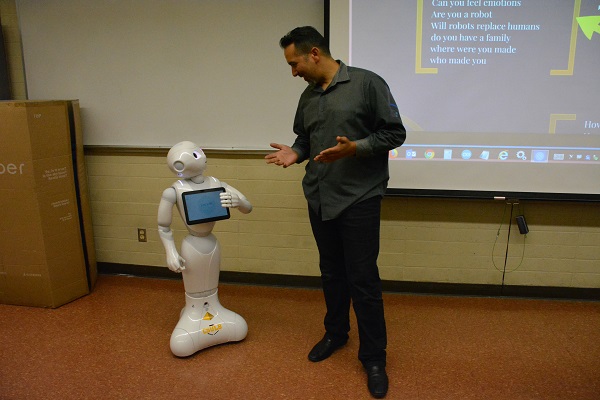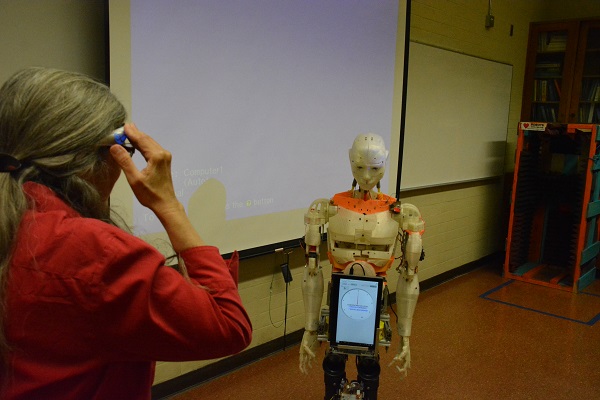by Dot Cannon
What if you could move a robot simply by thinking about it? What if a robot could gauge your emotions?
CSULB’s Electrical Engineering Professor Walter Martinez could tell you, that day is here.
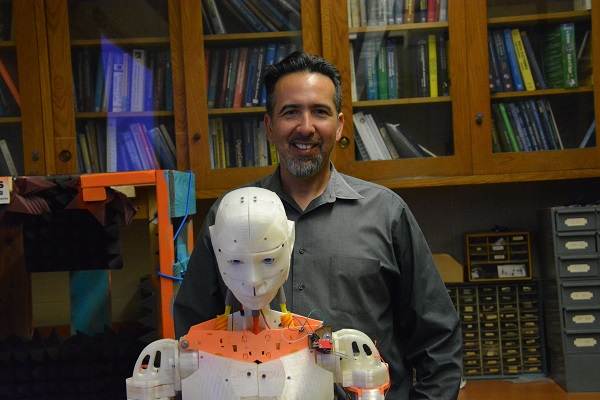
Walter, a robot enthusiast since the age of seven, is the secretary and past president of the nonprofit Robotics Society of Southern California.
During our recent visit, he brought two robots for a demonstration. (As you’ll hear from our interview, he’d also like to invite you to come learn more about them! Robotics Society has free monthly meetings at Cal State Long Beach.)
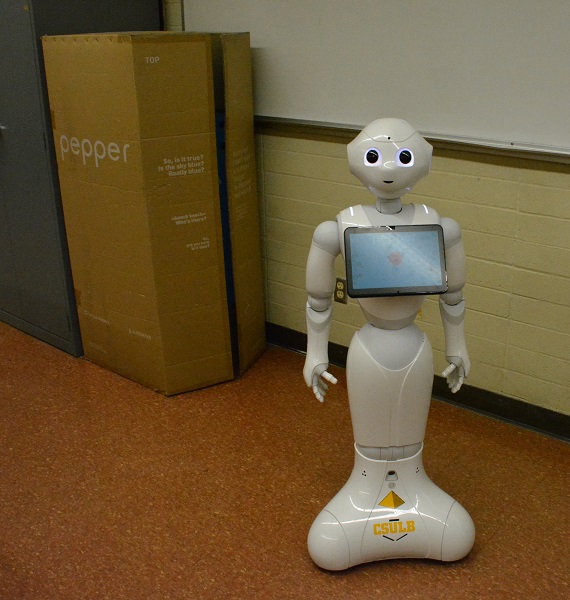
At this point, Walter says, he believes CSULB is the first, and only, college campus to have “Pepper” onsite. “Pepper”, which is made in France, has been around for four years but is not yet available on the consumer market. After winning a grant for his department, Walter was able to obtain a prototype of this social humanoid robot for research and study on-campus.
And “Pepper” can carry on a conversation–to the point of being almost eerie. She comes with a list of questions and instructions to which she’ll respond.
In addition, as Walter would demonstrate, she reacts to facial expressions.
Meanwhile, “Evo” is a robot Walter built, as we discussed in a previous interview. “Evo” is an InMoov, or the world’s first 3D printed life-size robot.
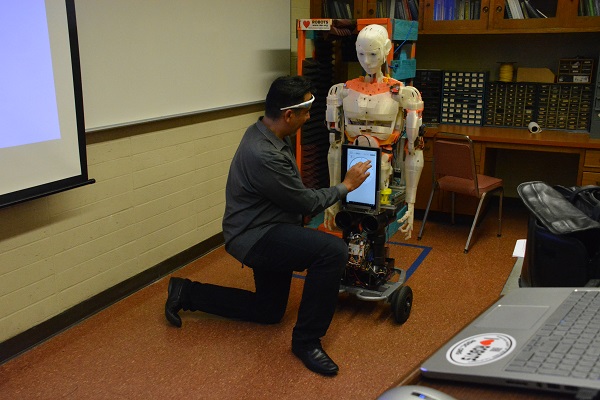
And he didn’t just stop with building. Once “Evo” was complete, Walter programmed him–to move in response to brain waves.
Brain to robot
Walter said he created a brain-computer interface to read the levels of beta waves from the brain. Once the Bluetooth device is on and the waves reach a certain level, he explained, the robot converts those levels to motion.
And we not only saw, but experienced, how this works.
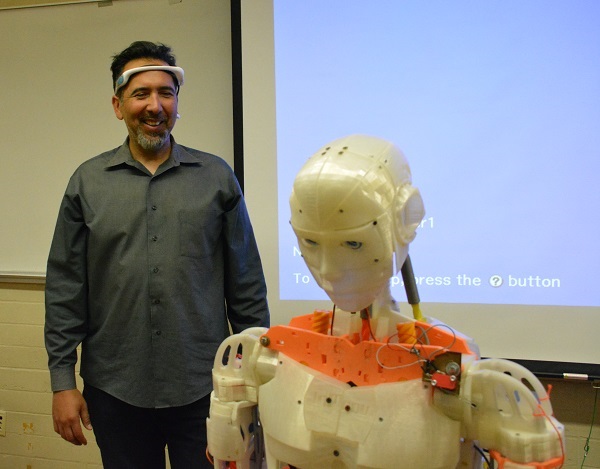
“First, we have to connect the EEG (electroencephalogram) device,” Walter explained. “This device basically has…metal sensors (that establish a connection with your skin and the ground. The ground’s going to be my earlobe).”
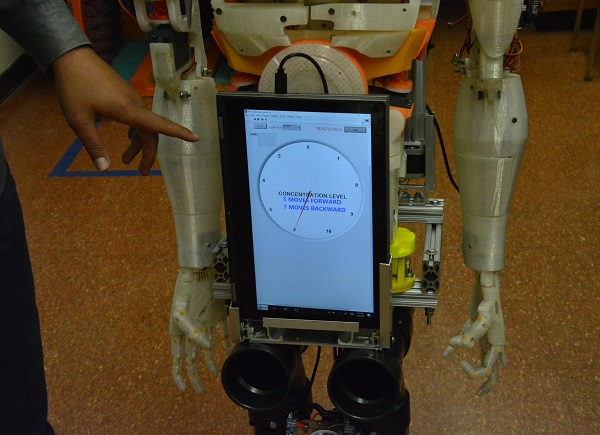
“So now it’s reading voltages, and I’m going to concentrate…Level 5 (beta waves) will make it move forward, and Level 7 will make it move backwards.”
With a hum, the robot moved towards him.
“There you go,” Walter said, as his concentration level increased and the robot moved backwards. “You have to practice, basically. Once you practice a lot, you know how much you have to concentrate…I kind of have a feeling now, how much I have to think…that he’s moving backwards, forwards, and concentrate on that.”
“The (CSULB) class that I’m teaching is how to make interfaces like this…so this is a cool demo for them.”
Interacting with “Pepper”
Next was humanoid robot “Pepper”. She turned her head as Walter spoke her name.
“As you wish,” she responded, complying as Walter asked her to raise her hand.
A conversation ensued, with Walter asking her questions like “Are you a robot?”, and “Can you feel emotion?”
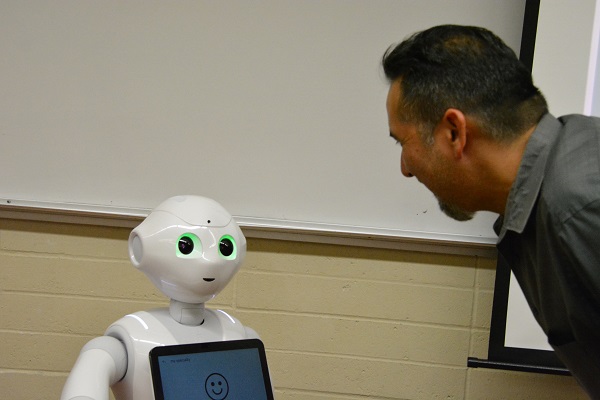
When it came to emotions, Walter demonstrated, Pepper can distinguish between happy or sad facial expressions. (According to creator Softbank Robotics’ website, she also determines emotions through the sound of a user’s voice.) She correctly identified Walter’s smile as an indication of happiness.
And, apparently, Pepper really enjoys human contact.
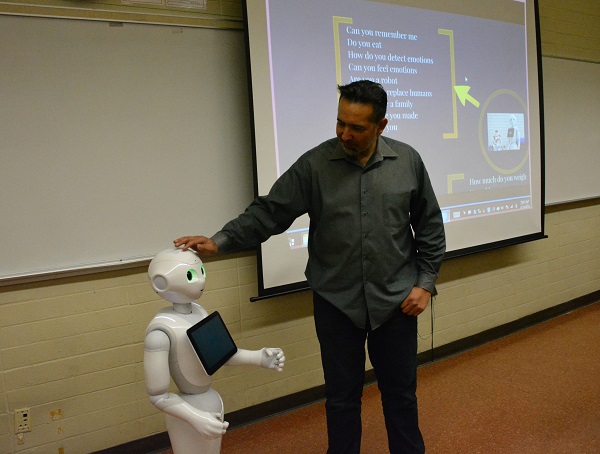
“I like it when you touch my head,” she commented. Later, in a second conversation, she offered, “You can touch my head…It tickles.”
A reporter’s firsthand experience
So, what works–and doesn’t work–when moving a robot with your brain, or conversing with one?
Well, at least in this case, mentally going through a very simple song lyric seemed to produce good results. My brain beta waves came up to Level Five, forward motion, as”Evo” moved forward quickly–and almost immediately.
Getting him to move backwards was more complicated.
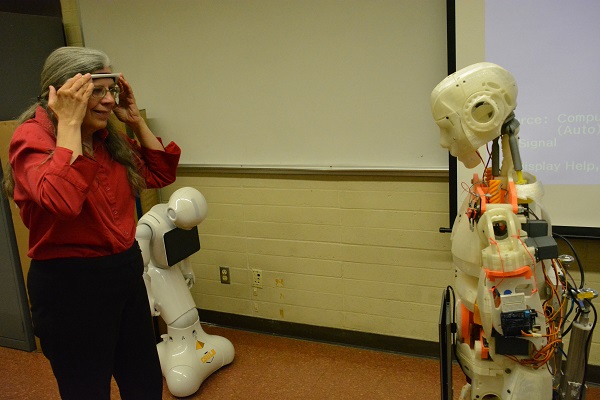
Reaching Level Seven on beta waves happened sporadically–possibly due to my concern that the robot might crash into something.
Interestingly, while Walter said in our previous interview that doing mental math increases his concentration level, I actually found my levels dropped when running through classical verse. A 1960s pop lyric from a commercial, though, appeared to focus my brain waves to “Evo” through the Bluetooth device very effectively.
And then, it was conversation time, with “Pepper”.
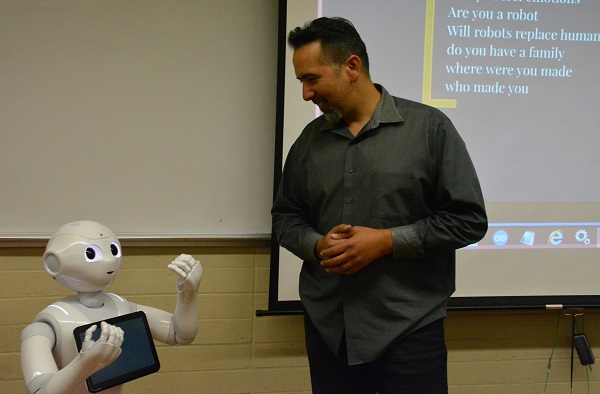
Pepper, Walter says, is one of a family of robots which Paris-based Softbank Robotics has created. She has two “brothers”: Romeo, created in 2009, and Nao, created about eight years ago.
To start a conversation, Pepper needs to focus on the speaker.
“You’ll see her eyes turn a little blue, when she’s focused on you,” Walter said.
Her responses seemed uncanny. Even Walter, who knows exactly how these robots are made, says he finds himself talking to them sometimes as though they were human.
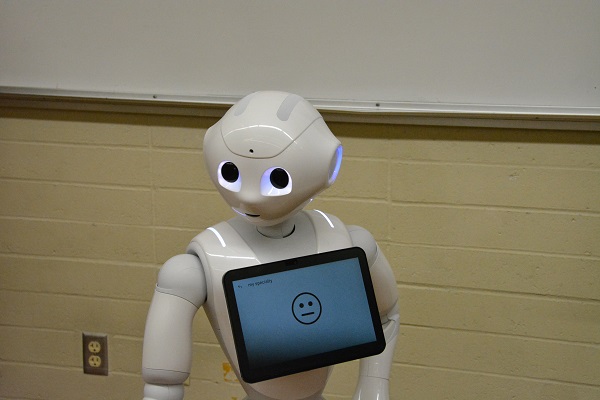
“I’m a humanoid robot…”, Pepper began, when asked to introduce herself. Accommodatingly, she added, “You can keep on asking me questions if you want.”
Interacting with her, the lesson seemed to be to speak clearly. A slangy, “How are ya?” elicited a tone and a suggestion that we talk about something else. In all probability, she’s not yet attuned to words running together.
But Pepper responded to my requests to raise her arms and make her hands move. She also appeared to ponder the question, “Are you human?”, replying with an electronic tone a couple of times before answering, “Of course.” And she gave her age as “four”, offering the information that she’s doing the best she can to become intelligent.
“Everything I know comes from the human mind,” she said.

Walter says that Softbank Robotics has acquired a number of AI companies. That artificial intelligence was apparent in Pepper’s concluding remarks.
“I’ve done my best to please you,” she commented. “Make sure you write a good article on Pepper.”
Would you like to learn more about “Pepper”, “Evo”, and various other robots with the Robotics Society of Southern California? Their next meeting happens on Saturday, June 9th, 10 am at Cal State Long Beach. RSSC meets on the second Saturday of every month, and everyone’s invited–whether you ever build a robot or not! Here’s the link for more information.
”

